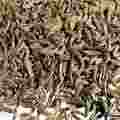 Caraway is often recognized the most typical spice of the German-speaking countries. It is an ancient spice of Central Europe: Caraway fruits have indeed been found in Neolithic villages (though that does only prove that the plant grew there, not that caraway was actually utilized), and since Roman times there is plenty of documentation for numerous culinary and medicinal application — not least to mention caraway-flavoured liquor, known as kummel in the USA, that is mostly produced and consumed in Northern Germany and Scandinavia (akvavit). Although caraway is a common plant of Alpine meadows at low elevation, is was grown systematically in medieval monasteries, mainly to its extremely effective antiflatulent powers (see also lovage); there is still some domestic production of caraway in Germany, although most now stems from Egyptian imports.
Caraway is often recognized the most typical spice of the German-speaking countries. It is an ancient spice of Central Europe: Caraway fruits have indeed been found in Neolithic villages (though that does only prove that the plant grew there, not that caraway was actually utilized), and since Roman times there is plenty of documentation for numerous culinary and medicinal application — not least to mention caraway-flavoured liquor, known as kummel in the USA, that is mostly produced and consumed in Northern Germany and Scandinavia (akvavit). Although caraway is a common plant of Alpine meadows at low elevation, is was grown systematically in medieval monasteries, mainly to its extremely effective antiflatulent powers (see also lovage); there is still some domestic production of caraway in Germany, although most now stems from Egyptian imports.
Caraway is the spice that gives Southern German and Austrian foods, be it meat, vegetable or rye bread, their characteristic flavour. It is also popular in Scandinavia and particularly in the Baltic states, but is hardly known in Southern Europe. True caraway aficionados use the whole fruits, but even the powder is strongly aromatic. Caraway’s aroma does not harmonize with most other spices, but its combination with garlic is effective and popular in Austria and Southern Germany for meat (e. g., roast pork Schweinsbraten) and vegetables. German Sauerkraut (sour cabbage made by lactic fermentation) is always flavoured with caraway (and juniper). Unfermented boiled cabbage without caraway lacks character. Some cheese varieties from Central Europe contain caraway grains; see also blue fenugreek.
Caraway is a controversial spice; to many, it appears dominant and unpleasant, especially to those who are not used to a cuisine rich in caraway. Usage of the ground spice is a working compromise; another method is wrapping the fruits in a small piece of linen cloth (or simply a tea bag) so that it can be removed before serving.
Caraway is of some importance in the cuisines of North Africa, mostly in Tunisia. Several recipes of Tunisian harissa [هريسة], a fiery paste made of dried chiles, call for caraway, and the same is true on a similar preparation found in Yemen, zhoug (see coriander).
Outside the indicated areas, caraway is rather uncommon. If you ever find references to caraway in books about Middle East, Indian or Far East cooking, then the most probable explanation is a translation mistake and you should probably read cumin. The same holds for the appearance of caraway in several Bible translations (see pomegranate for details). At last, there are some Indian cookbooks employing caraway for North Indian foods, but I suspect that black cumin is meant instead.
